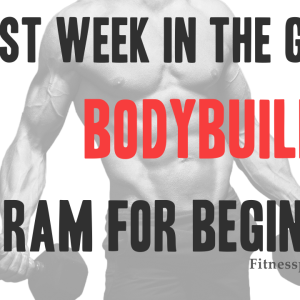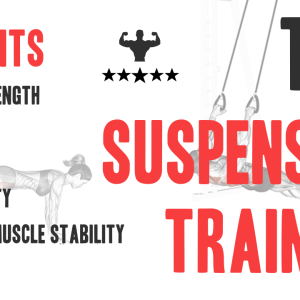Contents
The best core exercises offer a host of benefits that will strengthen your body’s foundation. A Strong and healthy core is the first thing you should start to train when getting into activity. With a strong core you will notice all the exercises will be easier to do.
What is Core?
The core is a group of hip and trunk muscles that surrounds the abdominal viscera, spine, and hips while also moving, supporting, and stabilizing your spine.
Your core acts as an axis along which the muscles of the hips, abdomen, and back interact to support and stabilize the spine, providing a solid base for movement in the legs and arms.
These solid foundations play an important role in the balanced and coordinated functioning of the muscles that provide upper and lower body mobility and efficiently direct the power to your limbs. This is why your core is often referred to as the “powerhouse” of the body.
What is the function of core muscles?
- Protects the spine from excessive load. For example, it is responsible for maintaining the strength, balance and mobility of the spine while transferring force from the lower body to the upper body.
- Your core muscles play a key role in everyday biological functions. It creates internal pressure within the abdominal cavity, holding the internal organs in place, and helping with the expulsion of air from the lungs and of bodily waste.
- While helping to transmit performance with increased strength and stability in challenging and dynamic sports, it plays an important role in reducing the risk of injury.
- Strong core muscles generate the strength, stability, and mobility needed to carry out everyday activities such as carrying shopping, climbing the stairs, and getting into a car.
Why you should strengthen your core muscles
Core training will enhance balance and stability. A strong core will improve your posture, it will improve functional movement, which is important to athletes, as well as anyone that needs to walk, bend, turn and lift things in their life, which is basically all of us. A strong core will also prevent back pain. Alot of people think that back pain is caused by a weak back. In most cases however weak abdominal muscles cause low back pain.
Fixing Posture Problems?
Almost everyone has some issue related to their posture. Over time, poor posture takes a tremendous toll on your spine, shoulders, hips, and knees. In fact, it can cause a cascade of structural flaws that result in acute problems, such as joint pain throughout your body, reduced flexibility, and compromised muscles, all of which can limit your ability to burn fat and build strength. Building your core strength can improve your balance and posture, limiting the impact of these problems, or prevent them from occurring in the first place.
Back Pain?
In reality, back pain can be classed as anything that puts your spine under unnecessary strain, resulting in tension in the back and placing stress on the muscles, ligaments, disks, and spinal joints.
If you spend much of your day sitting, you are particularly vulnerable to back, shoulder and neck pain because you develop tightness and weak spots along the posterior muscle chain, which includes the muscles running from the lower back down to the glutes, hamstrings and calves. If you are fit and your body is functioning properly and efficiently, this should not cause problems. However, back pain can occur if certain muscles or muscle groups are overactive, underactive, or imbalanced. Developing your core strength can increase your trunk strength, improve your back pain, or prevent them from occurring in the first place. (source)
A strong core can help you lift heavier loads.
Whether you are lifting weights, packing heavy boxes or carrying the groceries into the house, if you have a weak core you are an accident waiting to happen. Take time to strengthen your core. A balanced and focused core-training program can have a positive impact on your physical well-being as a whole.
What are the Core Muscles?
The core muscles are not only the abs, actually they include many muscles that work together to create a strong foundation in the body. Without this foundation you will never be able to utilize the full power of your arms and legs. It is very important that you include core exercises in your workout routine.
The muscles included in the core are:
- Rectus Abdominis: the muscles that make up the “six-pack”, located along the front of the abdomen.
- Transverse Abdominis (TVA): These are located under the obliques, they are the deepest of the abdominal muscles and they also wrap around your spine for stability and protection.
- External Obliques: located on the sides and slightly in the front of the abdomen.
- Internal Obliques: located under the external obliques, they however run in the opposite direction.
- Diaphragm: The diaphragm is known as the respiratory muscle, but it works in conjunction with other deep stabilizers, particularly the transverse abdominis and pelvic floor muscles, to provide trunk stabilization.
- Erector Spinae: It is the strong muscle group that keeps the spine straight. The erector spinae muscles consist of three muscle columns; spinalis, longissimus and iliocostalis. This group of three muscles travels down from your neck to your lower back.
- Quadratus lumborum: It is the deepest abdominal muscle, and commonly referred to as a back muscle. Contributes to the stabilization and movement of the spine and pelvis.
- Multifidus: The multifidus muscle is one of the core muscle stabilizers that plays an important role in static and dynamic spinal stability. Weakness in the multifidus muscle is associated with low back pain.
- Pelvic floor muscles; are the muscles that control the uterus, bladder, rectum, and small intestine. Pelvic floor exercises strengthen the muscles around your bladder, bottom, and vagina or penis. For this reason, pelvic floor exercises also play an active role in preventing many future diseases.
- Muscles of hip joint; They are grouped according to their movements and functions as Flexors, Extensors, Abductors, Adductors, Internal and External Rotators. Hip muscles included in the core muscles include the psoas, iliacus, gluteus maximus, gluteus medius (anterior and posterior fibers), rectus femoris, and hamstring muscle group. (source)

What is core strength?
Core strength is the ability to perform demanding physical tasks that require control. As it involves all of the muscles of your core—both deep and superficial— it has a key role in core training, but it is important to remember that good core strength requires a foundation of good core stability first.
Benefits of Core Strengthening Exercises
- Increases speed and agility
- Enhances all-round body strength and function
- Helps enhance power of your movements
- Makes it easier to perform a range of everyday tasks
- Improves performance in sporting activity
- Creates lean muscle tone
- Improves balance and control
Core Strengthening Exercises
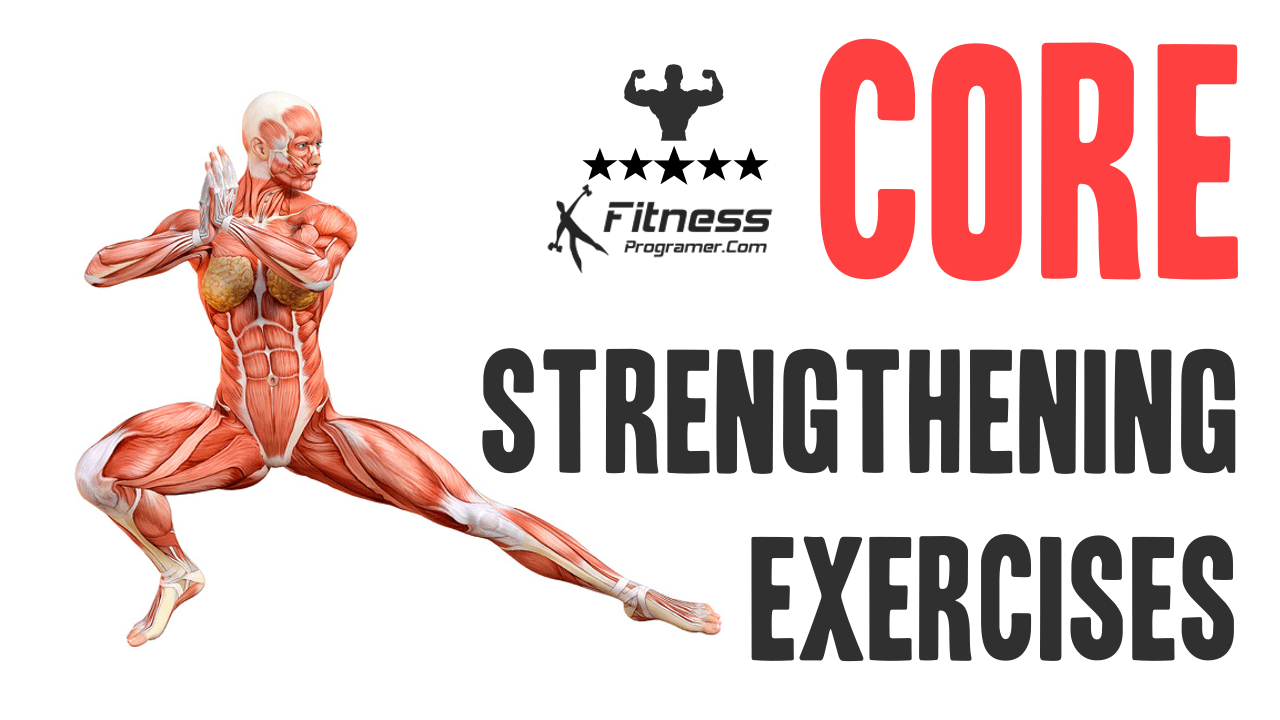
The exercises in this section are the building blocks of good core strength and stability. You should aim to master them before moving on to those in the Intermediate and Advanced sections. To ensure that you get the best results, focus on performing each exercise correctly, maintaining good form throughout and controlling the movements with your core.
1- Sit-ups
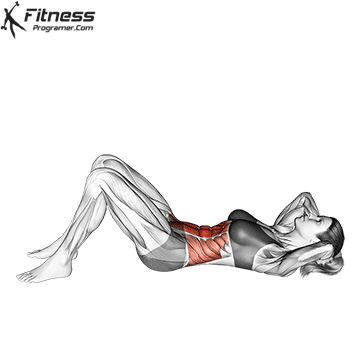
The sit-up is a well-used and effective exercise for strengthening abdominals and increasing hip flexion. Focus on using your core to drive the movement, and avoid straining your neck.
Target Muscles: ▪ Rectus abdominis ▪ Transverse abdominis ▪ External obliques ▪ Internal obliques ▪ Pelvic floor ▪ Multifidus ▪ Quadratus lumborum ▪ Hip flexors
Movement: Flexion
Alternative Core Exercises: CRUNCHES – CRUNCH WITH LEG RAISE – TUCK CRUNCH – DOUBLE CRUNCHES – LONG ARM CRUNCH
2- OBLIQUE FLOOR CRUNCHES
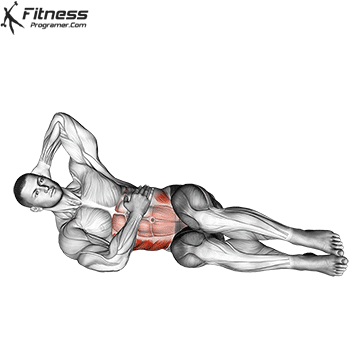
This exercise improves your strength and core stability, and targets your external and internal obliques, improving trunk stability and side flexion. To avoid straining your neck, ensure that you support your head with your hand and control the movement with your core. For maximum effect, perform the movement slowly.
Target Core Muscles: ▪ Rectus abdominis ▪ Transverse abdominis ▪ External obliques ▪ Internal obliques ▪ Pelvic floor ▪ Multifidus ▪ Quadratus lumborum
Movement: Side Flexion
3- CROSS CRUNCH
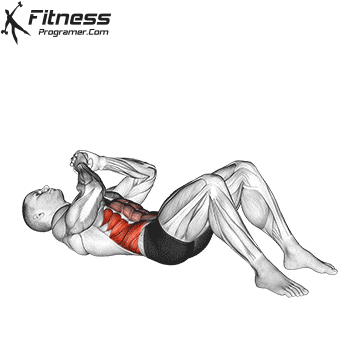
This simple but effective core exercise works your obliques and transverse abdominis, building both rotational strength and the ability of your core to stabilize your spine and hips against external rotational forces.
Target Core Muscles: ▪ Rectus abdominis ▪ Transverse abdominis ▪ External obliques ▪ Internal obliques ▪ Pelvic floor
Movement: Side Flexion
Alternative Core Exercises: Half Cross Crunch – Russian Twist
4- MEDICINE BALL CRUNCH

Performing the exercise while holding a medicine ball increases the load on your abs, making the movement more challenging.
Target Core Muscles: ▪ Transverse abdominis ▪ Pelvic floor ▪ Rectus Abdominis ▪ Internal Obliques
Movement: Flexion
5- FLOOR HYPEREXTENSION

This simple exercise helps strengthen the spinal stabilizing muscles of your lower back. Aim to perform the movement with good form and avoid jerking up with your shoulders, which can strain your neck.
Target Core Muscles: ▪ Erector spinae ▪ Transverse abdominis ▪ Pelvic floor ▪ Gluteus maximus ▪ Multifidus ▪ Quadratus lumborum
Movement: Extension
6- Dumbbell Side Bend

This exercise is a simple but effective way of strengthening your obliques, and stabilizing your spine against lateral and rotational forces. Practice with a light weight until you have perfected the movement—focus on controlling the upward and downward phases with your core, rather than using your arms to raise and lower the dumbbell.
Target Core Muscles: ▪ Transverse abdominis ▪ External obliques ▪ Internal obliques ▪ Pelvic floor ▪ Multifidus ▪ Quadratus lumborum ▪ Gluteus maximus
Movement: Side Flexion
7- Heel Touch

This side flexion exercise works your obliques, improving trunk stability and control. Good form is key—ensure that you control the movements with your core.
Target Core Muscles: ▪ Rectus abdominis ▪ Transverse abdominis ▪ External obliques ▪ Internal obliques ▪ Pelvic floor ▪ Multifidus ▪ Quadratus lumborum
Movement: Side Flexion
8- Roman Chair Side Bend
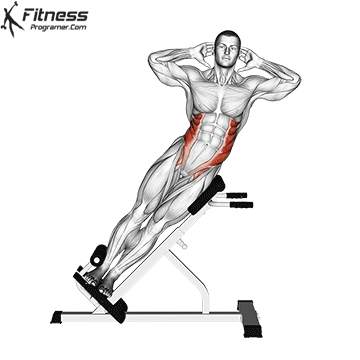
An effective side flexion movement, this exercise is best performed on a Roman chair—a piece of apparatus that has a ledge behind where you can secure your feet. It may also be done on a regular bench, but you will need a partner to hold your feet.
Target Core Muscles: ▪ Rectus abdominis ▪ Transverse abdominis ▪ External obliques ▪ Internal obliques ▪ Pelvic floor ▪ Multifidus ▪ Quadratus lumborum ▪ Gluteus maximus
Movement: Side Flexion
9- HALF WIPERS
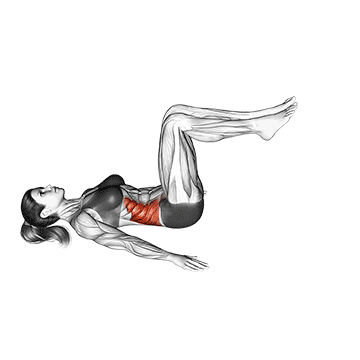
This exercise strengthens your abdominals and lower back, as well as improving the general mobility of your lower and midback. While carrying out the movement, it is important to focus on keeping your upper back and shoulders in a consistent, stable position, in order to avoid rolling your whole body from side to side when you move your legs and hips. To begin with, you may find it helpful to use your outstretched arms to brace against the floor, and to find a point on the ceiling on which to fix your gaze to avoid moving your head.
Target Core Muscles: ▪ Transverse abdominis ▪ External obliques ▪ Internal obliques ▪ Pelvic floor ▪ Multifidus ▪ Quadratus lumborum ▪ Gluteus maximus ▪ Gluteus medius ▪ Gluteus minimus ▪ Hip flexors
Movement: Rotation
10- Glute Bridge

This simple but effective exercise activates the stabilizing muscles of your lower back and buttocks, and offers additional benefits to your hamstrings. It is an important core-stabilizing movement for helping to improve your posture —especially if you spend a lot of time sitting at a desk. It is a very versatile exercise with a wide range of potential variations and progressions.
Target Core Muscles: ▪ Rectus abdominis ▪ Transverse abdominis ▪ Pelvic floor ▪ Erector spinae ▪ Multifidus ▪ Quadratus lumborum ▪ Gluteus minimus ▪ Gluteus medius ▪ Gluteus maximus
Movement: Isometric
Alternative Core Exercises: BODYWEIGHT HIP THRUST
how to do:
1- Lie on your back with your knees bent and your feet flat on the floor, hip-width apart. Keep your arms at your sides, palms facing down. Relax your neck and shoulders.
2- Engaging your core, slowly lift your buttocks off the floor until your body is in a straight line from your knees to your shoulders.
3- Hold at the top of the movement, then reverse slowly and with control to return to the starting position.
11- BICYCLE CRUNCH
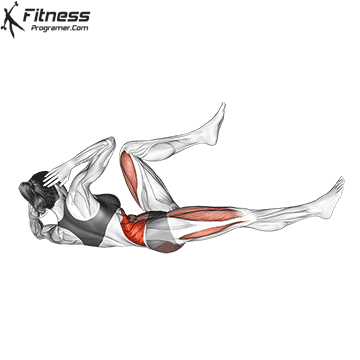
This exercise requires a combination of flexibility, stamina, and mobility. Always make sure that you are performing it with good, even form: ensure that you curl up and rotate your trunk, avoiding jerking your head or straining the neck muscles.
Target Core Muscles: ▪ Rectus abdominis ▪ Internal obliques ▪ ▪ External obliques Transverse abdominis ▪ Pelvic floor ▪ Multifidus ▪ Quadratus lumborum
Movement: Isometric
12- Bodyweight Single Leg Deadlift
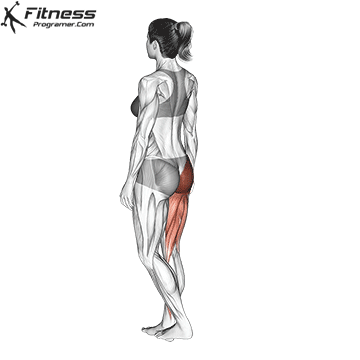
This exercise is excellent for improving your core stability, balance, and coordination, as well as your hamstring flexibility. It is therefore often used to help with the rehabilitation of lower-body injuries. Practice in front of a mirror to perfect your form, and remember to perform the same number of reps for each side of your body.
Target Core Muscles: ▪ Transverse abdominis ▪ Pelvic floor ▪ Erector spinae ▪ Multifidus ▪ Quadratus lumborum ▪ Gluteus minimus ▪ Gluteus medius ▪ Gluteus maximus
Movement: Isometric
13- Leg Raise
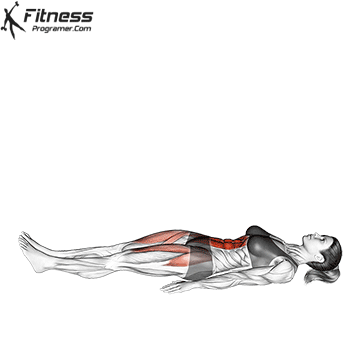
This reasonably demanding core exercise helps build stability in the deep core muscles of your spine as well as providing a great workout for your abs. Make sure that you maintain good form throughout to avoid placing any stress on your lower back.
Target Core Muscles: ▪ Rectus abdominis ▪ Transverse abdominis ▪ Pelvic floor ▪ Hip flexors ▪ Multifidus ▪ Quadratus lumborum ▪ Gluteus minimus ▪ Gluteus medius
Movement: Isometric
Alternative Core Exercises: FLUTTER KICK –
14- Plank
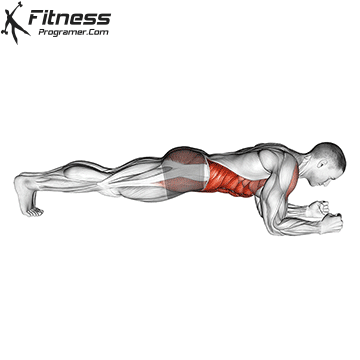
This excellent isometric exercise engages your core and many major muscle groups of the upper and lower body. Good form is key—make sure you maintain a straight line through your body, from shoulders to ankles.
Target Core Muscles: ▪ Rectus abdominis ▪ Transverse abdominis ▪ Pelvic floor ▪ Erector spinae ▪ Multifidus ▪ Quadratus lumborum ▪ Gluteus minimus/medius ▪ Gluteus maximus
Movement: Isometric
Alternative Core Exercises: Front to Side Plank – Front Plank with Arm Lift – Side Plank – Plank Leg Lift – Side Plank Leg Raises
Intermediate Core Strengthening Exercises
The exercises in this section build on those in Foundation, with the challenges of added instability, movement, weight, and power to make your core work harder and with greater functionality. Concentration and good technique are vital, and it is important that you can perform the less-advanced exercises with confidence before you try any of these.
1- Hanging Knee Raises
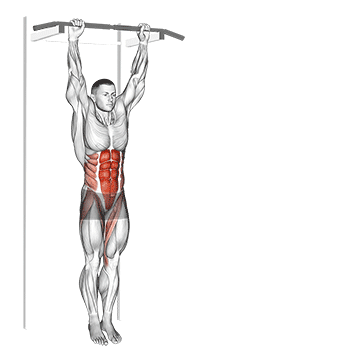
This simple but demanding exercise works your abdominals and hip flexors, while helping to elongate your spine. Good core control is key and it is vital to keep your torso as stable as possible, rather than jerking with your back, which can cause injury.
Target Core Muscles: ▪ Rectus abdominis ▪ Transverse abdominis ▪ Pelvic floor ▪ Hip flexors
Movement: Flexion
2- Kettlebell Windmill
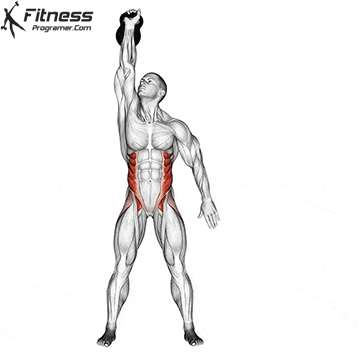
This exercise offers a good workout for your obliques, with added benefits for your glutes, legs, and shoulders. Begin with a light kettlebell, while increasing the size of the weight as you progress to make the exercise more challenging.
Target Core Muscles: ▪ Transverse abdominis ▪ External obliques ▪ Internal obliques ▪ Pelvic floor ▪ Erector spinae ▪ Quadratus lumborum ▪ Gluteus minimus ▪ Gluteus medius
Movement: Side Flexion
Alternative Core Strengthening Exercises: Dumbbell Windmill
How to do:
1- Stand with your feet slightly more than shoulder-width apart, holding a kettlebell in your left hand. Raise the weight above your left shoulder, allowing your right arm to hang by your side.
2- Keeping the kettlebell aloft and pivoting at your hips, drop your torso to the right, reaching toward the floor with your right arm and bending your right knee. Turn your head in the direction of the kettlebell as you do so.
3- Continue reaching down as far as you can with your right hand, keeping the kettlebell in position and your head turned toward it. Hold briefly, then return to the start position. Complete your reps, then switch sides.
3- Good Morning
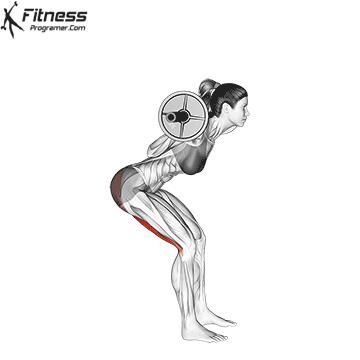
This excellent extension exercise works the stabilizing muscles of your spine, while strengthening your glutes and improving hip mobility. As your hip flexibility increases, you may be able to lower your upper body so that it is parallel to the floor.
Target Core Muscles: ▪ Transverse abdominis ▪ Pelvic floor ▪ Erector spinae ▪ Multifidus ▪ Gluteus maximus
Movement: Extension
Alternative Core Strengthening Exercises: Smith Machine Good Morning – Good Morning With Resistance Band
4- HYPEREXTENSION
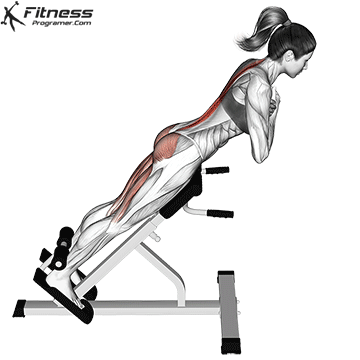
This is a great core exercise for improving hip strength and mobility. As with the good morning (above), as your hip flexibility improves, you will be able to lower your torso even farther.
Target Core Muscles: ▪ Transverse abdominis ▪ Pelvic floor ▪ Erector spinae ▪ Multifidus ▪ Gluteus maximus
Movement: Extension
Alternative Core Exercises: Weighted Back Extension
5- Landmine Twist
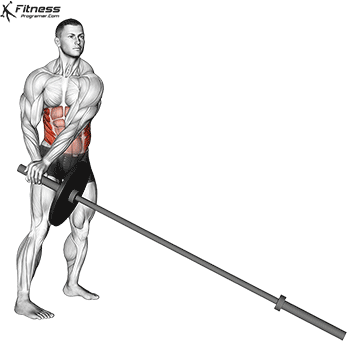
This excellent rotational exercise uses an arcing movement that works a large group of muscles in unison. As a result it offers a useful full-body multi-joint movement that makes a good addition to any core-strength exercise programme.
Target Core Muscles: ▪ Transverse abdominis ▪ External obliques ▪ Internal obliques ▪ Pelvic floor ▪ Quadratus lumborum ▪ Gluteus minimus ▪ Gluteus medius
Movement: Rotation
Alternative Core Exercises:
How to do:
1- Continue the movement, turning the end of the bar in a forward, clockwise motion, keeping the other end pressed against the weight.
2- Follow the movement back and through the start position to your left, keeping your core engaged and maintaining good form.
3- Control the movement to your left, keeping your legs still and moving from your hip, and pivoting the bar from the weight on the floor.
6- Mountain Climber
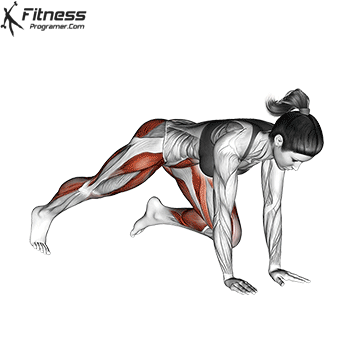
The mountain climber is a dynamic movement that is excellent for building core stamina, while also improving your core strength, balance, and agility. It is especially useful if you have little equipment but want a challenging all-body workout.
Target Core Muscles: ▪ Transverse abdominis ▪ Pelvic floor ▪ Hip flexors ▪ Erector spinae ▪ Multifidus ▪ Quadratus lumborum ▪ Gluteus medius ▪ Gluteus maximus
Movement: Isometric
Alternative Core Exercises: Cross Body Mountain Climber – Spider Plank
7- Russian Twist
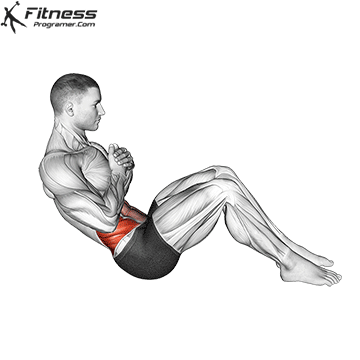
This exercise is designed to improve your spinal flexibility, as well as building strength across your core. As with any movement that twists the spine, be sure to carry it out with good form and control.
Target Core Muscles: ▪ Transverse abdominis ▪ External obliques ▪ Internal obliques ▪ Pelvic floor ▪ Erector spinae ▪ Multifidus ▪ Quadratus lumborum
Movement: Rotation
Alternative Core Exercises:
8- Medicine ball Overhead Slam
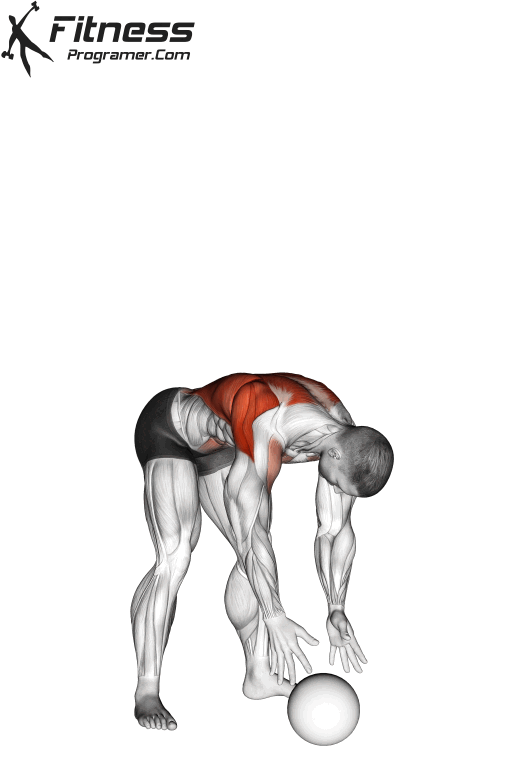
This powerful, dynamic exercise offers your core a great workout, with added benefits for your shoulders. Focus on keeping your body as balanced as possible throughout, and start with a reasonably light ball, until you can carry out the movement with good form and confidence. You should enlist the help of a partner to retrieve the medicine ball and prevent it from interfering with the activities of other gym users.
Target Core Muscles: ▪ Transverse abdominis ▪ Pelvic floor ▪ Rectus Abdominis
Movement: Flexion
9- Kettlebell Swings
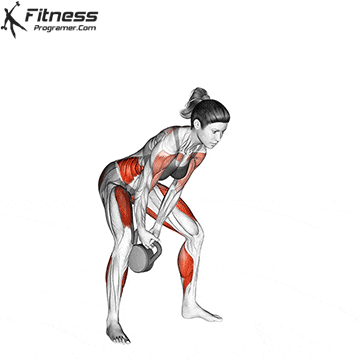
This whole-body exercise works the muscles of your glutes, lower back, and hips. Allow the kettlebell to hang loosely from your arms and generate the force of the movement from your hips, rather than trying to “muscle” the weight up with your upper body.
Target Core Muscles: ▪ Rectus abdominis ▪ Transverse abdominis ▪ Pelvic floor ▪ Hip flexors ▪ Erector spinae ▪ Multifidus ▪ Quadratus lumborum ▪ Gluteus minimus/medius ▪ Gluteus maximus
Movement: Isometric
Alternative Core Exercises: One Arm Kettlebell Swing – Swing | Gymstick
10- SWISS BALL ROLLOUT
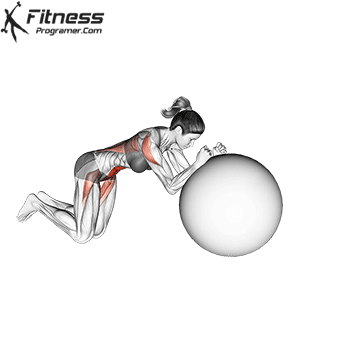
In a similar way to the plank, this excellent core exercise builds stability and strength in the muscles of your abdomen and lower back, with the added challenge of forward movement, working your upper back and shoulder stability.
Target Core Muscles: ▪ Transverse abdominis ▪ Pelvic floor ▪ Erector spinae ▪ Multifidus ▪ Gluteus maximus
Movement: Complex
Alternative Core Exercises: Standing Barbell Rollout – Barbell Rollout – Ab Wheel Rollout
Advanced Core Strengthening Exercises
The exercises in this section involve challenging and complex movements that require excellent all-round core strength, stability, and mobility to perform correctly. It is therefore important that you do not attempt any of them until you have mastered the exercises in the previous sections and can perform them confidently with optimum form and technique.
1- JACKKNIFE SIT-UPS (V-UP)
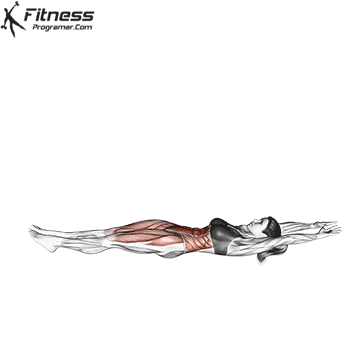
This exercise demands excellent core control and flexibility, and takes practice to perfect. It is important to focus on good form and control the upward and downward phases with your core, rather than straining with your legs or back, which can cause injury.
Target Core Muscles: ▪ Rectus abdominis ▪ Transverse abdominis ▪ Pelvic floor ▪ Hip flexors
Movement: Flexion
Alternative Core Strengthening Exercises: DUMBBELL V-UP – EXERCISE BALL FROG CRUNCH – V-UP DOWN WITH STABILITY BALL – FROG CRUNCH – Teaser Pilates
2- STABILITY BALL KNEE TUCK
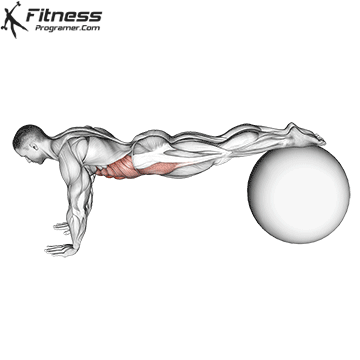
This difficult core flexion exercise demands excellent core stability, balance, and control to perform correctly. Because the movement can potentially cause injury when performed with poor form, you should only attempt it after you have mastered a good range of basic core exercises.
Target Core Muscles: ▪ Rectus abdominis ▪ Transverse abdominis ▪ Pelvic floor ▪ Erector spinae ▪ Quadratus lumborum ▪ Gluteus maximus
Movement: Flexion
Alternative Core Exercises: TRX MOUNTAIN CLIMBER
3- STANDING CABLE HIGH-TO-LOW TWIST
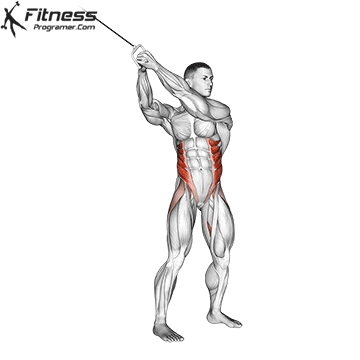
This exercise is a powerful core-rotational exercise that is excellent for improving spinal control and stability, and building rotational strength.
Performing the chop while standing makes your core muscles work harder to generate rotational power. Keep your back straight, and avoid trying to “muscle” the movement down with your arm or shoulders.
Target Core Muscles: ▪ Rectus abdominis ▪ Transverse abdominis ▪ External obliques ▪ Internal obliques ▪ Pelvic floor ▪ Quadratus lumborum
Movement: Rotation
Alternative Core Exercises: STANDING CABLE LOW-TO-HIGH TWIST – STANDING CABLE TWIST – CABLE SEATED CROSS ARM TWIST – SEATED CABLE TWIST – CABLE SEATED TWIST ON FLOOR
4- Dragon Flag
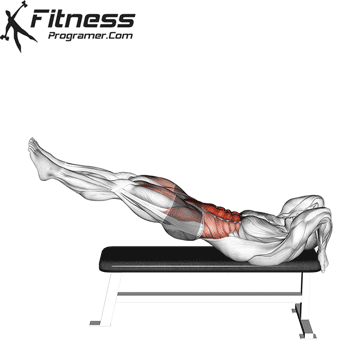
This exercise is designed to strengthen the muscles that support the spine. Before attempting a dragon flag movement, you should make sure that you have worked your way up to advanced core training.
Target Core Muscles: ▪ Rectus Abdominis ▪ Transverse abdominis ▪ Obliques ▪ Multifidus ▪ Pelvic floor ▪ Quadratus lumborum ▪ Erector Spinae
Movement: Isometric
5- Barbell Hip Thrusts
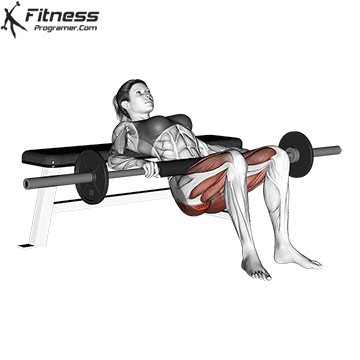
The target muscle group of the barbell hip thrusts exercise is the hip muscles. But the barbell hip thrust exercise activates all the core muscles, including the transverse abdominis, rectus abdominis, and obliques.
Target Core Muscles: ▪ Rectus Abdominis ▪ Transverse abdominis ▪ Obliques ▪ Multifidus ▪ Pelvic floor ▪ Quadratus lumborum ▪ Erector Spinae ▪ Gluteus maximus ▪ Gluteus medius ▪ Gluteus minius ▪ Hip flexor
Movement: Extension
6- Turkish Get-up
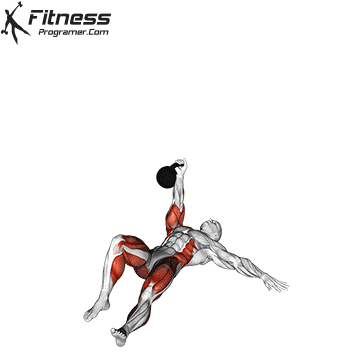
This ungainly but highly functional exercise offers an unusual but effective challenge for your core muscles. The basic movement involves raising your body up from a prone position while holding a weight aloft with one hand—in this case a kettlebell. Remember to perform equal numbers of reps with each hand.
Target Core Muscles: ▪ Transverse abdominis ▪ External obliques ▪ Internal obliques ▪ Pelvic floor ▪ Hip flexors ▪ Quadratus lumborum ▪ Gluteus minimus/medius ▪ Gluteus maximus
Movement: Complex
How to do:
1- Stand with the pulley to your right, keeping your back and legs straight, and your shoulders and hips aligned. Keeping your arms extended, grasp the cable handles.
2- Engaging your core, pull the cable down and across your body, bending your elbows as you reach the midpoint of your chest. Keep your shoulders straight.
3- Keeping the cable close to your body, push down with your arms to finish the movement. Hold briefly and return to the start position. Switch sides.
7- TOES TO BAR
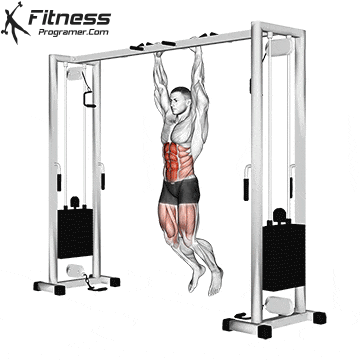
This exercise -effectively a more demanding version of the hanging knee-up- may look deceptively simple but it is difficult to perform. Good form is crucial. You must keep your upper body as still and as stable as possible, controlling the movement with your hip flexors and glutes, rather than trying to use momentum.
Target Core Muscles: ▪ Rectus abdominis ▪ Transverse abdominis ▪ Pelvic floor ▪ Hip flexors ▪ Gluteus maximus
Movement: Flexion
Alternative Core Exercises: CAPTAINS CHAIR LEG RAISE –
8- HANGING WINDSHIELD WIPER
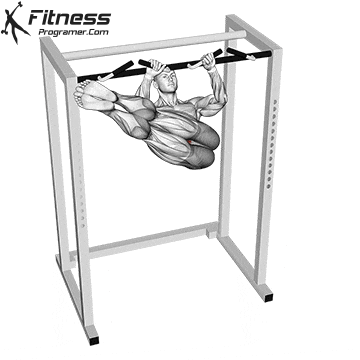
The hanging windshield wiper is an advanced core training exercise that is also extremely challenging to other muscles of the upper body, including the lats, biceps, and grip. All core and abs muscles are fully activated while preforming this advanced exercise.
During this move, your upper abs undergo a strong isometric contraction, while your lower abs do a substantial amount of work, and your obliques are trained hard.
Target Core Muscles: ▪ Rectus Abdominis ▪ Transverse abdominis ▪ Internal Obliques ▪ Multifidus ▪ Quadratus lumborum ▪ Erector Spinae ▪ External Obliques ▪ Hip flexor
Movement: Complex
9- Human Flag
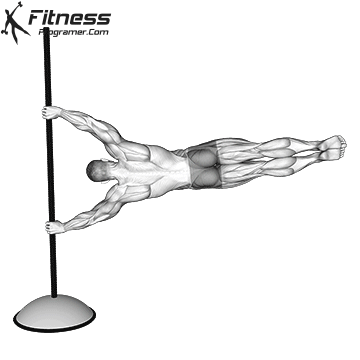
A high-level calisthenics movement, this exercise requires special practice and advanced levels of skill and precision. In order to perform an human flag, it’s important to have strong arm and core muscles.
Target Core Muscles: ▪ Rectus Abdominis ▪ Transverse abdominis ▪ Obliques ▪ Multifidus ▪ Quadratus lumborum ▪ Erector Spinae ▪ Gluteus maximus ▪ Hip flexor
Movement: Isometric
STATIC STRETCHES
Static stretches should always be performed after exercise to help your muscles relax and prevent them from becoming shortened, which can lead to injury.
Try to combine a range of seated and standing stretches to work a full range of muscles, and be sure to breathe deeply and rhythmically, inhaling before each stretch and exhaling during the movement.
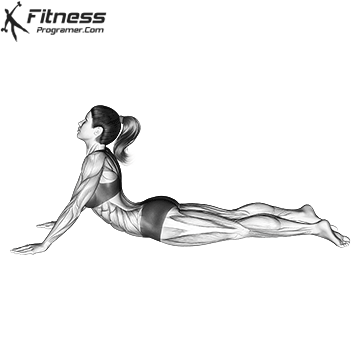
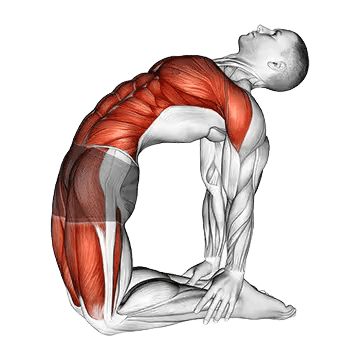
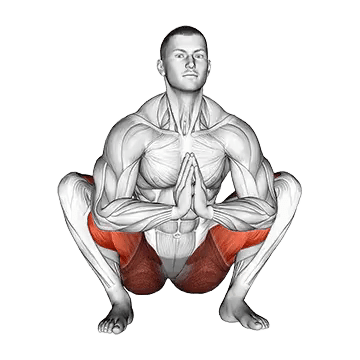
Conclusion
Core training is most effective when the all the muscles of the torso work together as a solid unit and both front and back muscles contract at the same time, multi joint movements are performed and stabilization of the spine is constant.
There are many exercises that will strengthen the core. Many core fitness training exercises can be done at home with no equipment …there are some that require the use of equipment and gadgets, but the best are actually the ones that are possible by just using your body.


